After a tremendous summer of
fun with the Gary
Dierking designed Ulua outrigger, I thought an
update of sorts would be fun for those who are interested in
messing about. Last time I wrote an article, I had planned some
modifications to my Ulua named Anhinga. I had build Anhinga
to be a two person paddle craft with a single ama, a trimaran
with a big freestanding mast, and the possibility of adding
a second hull to make a camp cruising catamaran with a large
capacity. I ended up after the first summer being dissatisfied
with the way everything worked together since I had made so
many changes to a great design. More sail, bigger amas, longer
hull, and the trimaran option added too much weight. I had too
little freeboard to avoid getting swamped by the frequent powerboat
wakes on the lakes at my in-law’s cabin. I always find
it interesting that powerboat drivers will often slow down off
a plane and drag their biggest possible wake thinking they are
doing you a favor by their reduced speed. Anyhow, the lightening
program began in earnest last winter.
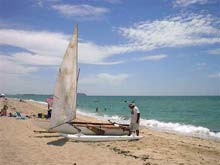 |
I ended up seeing a picture
of R. Coehn’s Ulua pulled up on the beach... |
| ... and another of Ulua tied up at the dock
and that cinched it for me. |
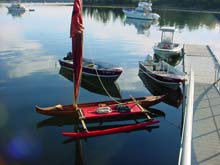
|
After seeing the images I decided to make the second set of
iakos that would hold a single ama. I would reuse the port ama
since the Hawaiian traditionally rig it up that way. Additionally,
I dedicated myself to finishing the outboard bracket, rudder,
and leeboard as shown in Gary’s excellent plans. Finally,
I wanted to switch to a lighter rig. Gary emailed me photos
of his Wa’apa that uses a stub mast rig allowing a full
height windsurfing rig to set the most possible sail. In my
case, however, that is at the first reef point at 85 square
feet rather than the full hoist of 128 square feet. I had previously
found some alarming twist in the hull paddle steering with my
oversized sail. The new rig and the reef took care of that problem.
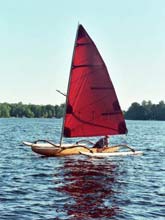 |
Here’s a shot of
me paddle steering solo. Not a great idea since I can’t
release the sheet. That’s the old rig at full hoist,
trimaran beams, and no tramps. |
| Here is a shot of the Ulua with tramps and
second passenger. The low slung look is sweet if it were
decked to avoid swamping. |
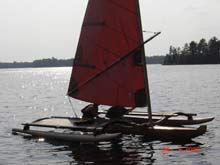
|
Also adding insult to injury was the fact that paddle steering
necessitates one to sit aft. When single handing it also made
releasing the sheet to ease wind pressure an iffy proposition
since paddle steering requires two hands. So the conversion
to a rudder was welcome. I ended up buying an old mahogany dingy
rudder with an aluminum rudder head and a nice tiller and tiller
extension. Once mounted on the new iako set, however, the blade
had little area in the water. I resolved to err on the big side
and went to work in the woodshop at school. I made a 0009 blade
out of a glued up blank of red oak (not a good wood choice)
and a 0012 leeboard out of two pieces of red oak glued face
to face to eliminate some of the inherent warpage. I was so
keen to use them that I launched without finishing them or varnishing
the wood. Major warpage while wet was the result, but the grin
on my face was worth the added trouble since these items had
transformed the boat completely for me. I just ripped the super
thin trailing edge off and varnished them.
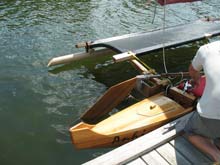 |
This photo shows the single
outrigger, the new iakos, the motor mount, and the new
rudder. I need to add weight to the rudder to keep it
down or use a line (shown) that will allow kicking up
(not figured out yet). The line isn’t too easy to
rig since the rudder is on the motor mount. I should probably
skip the aluminum rudder head and go with Gary’s
design—but I’ve got a bit of cash tied up
in it and would like to make it work as is. Any ideas? |
The result of using the rudder rather than paddle steering
for me was huge. I can now sit in the middle of the boat and
center my weight—critical in narrow canoes. I can beat
to weather quite effectively thanks to these two foils. Additionally
thanks to the tiller extension, I can sit either on the tramp
or on the opposite gunwale to add a bit of hiking power.
| Sailing port and starboard tack using tiller
extension to sit hiked out. |
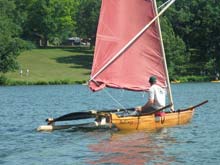
|
 |
Note the additional freeboard! |
The change in rig was the best part of the conversion for me.
I adopted Gary’s stub mast rig and left the 23’
rig in the garage. My father in law had an old but perfect windsurfer
with a fiberglass mast and universal joint sitting around unused.
Coupled with a cedar 4x4 turned into a round stub mast, I had
my new rig! I used the same sprit boom as previously—obviously
too long before, but now a bit ridiculous in the reefed position.
All told the cost of the new rig was nothing. Stepping the old
rig solo was a life endangering proposition. Stepping the new
one was a piece of cake, and the whole mess weighed 10-15#.
Since muluay first mast pictured below had mast track, I laced
the sail to the windsurfing mast using parachute cord and a
windsurfing cup for the top of the mast. No halyard is needed
since there is no reef point left on this shorter mast.
| Here’s a shot of the first mast. It
was tough to step even with two! However, one can see the
universal joint on the beam just aft of the mast. This was
the future. |
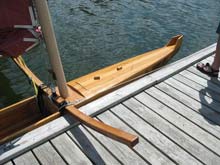
|
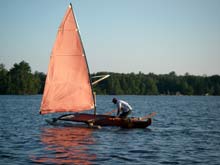 |
Here is the stub mast
with the windsurfer rig lashed to it. |
I haven’t finished rigging it quite yet as Gary likes
the windsurfing mast to be drawn up tight to the stub mast,
through a bee hole or dumb sheave, out to the bow, and back
to a cleat. That way the entire rig can be struck in a moment.
In my case since I started with a fully battened sail, it is
of little help to drop the sail since the mast and sprit boom
make the sail cover both the canoe and the tramp. The designed
sail would be better here as the battenless sail would collapse
neatly into a bundle allowing it to be lashed to the tramp and
totally out of the way. I may convert to that sail style eventually
since it really makes it so convenient to store, raise, and
strike. If I can convince myself to live with a bit less sail
area, I saw a lateen pirate sail for 200 bucks…
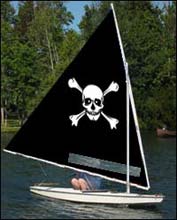 |
Lateen pirate sail |
So essentially I have changed the boat from a trimaran to a
tacking outrigger while adding a rudder and a leeboard. The
switch to the windsurfer mast was also hugely beneficial although
I can no longer set the full sail. Not seeing the twist in the
hull makes me glad to sail with a reef as a broken hull would
ruin my day. Incidentally, that was the way the boat was drawn
up. Gary did anticipate the triamaran option, however, I had
failed to execute it very well.
In the interim, I had these extra trimaran iakos, tramps,
and so forth. I contacted Chris
Ostlind for a custom design that would add true
trimaran performance while making use of my (for me) big investment
in a nice custom sail and trampolines. He designed the Cardiff
21 that appeared in SCA
a couple of issues ago and looks like this.
| Chris designs and builds some really nice
sailing canoes. He is a creative guy. |
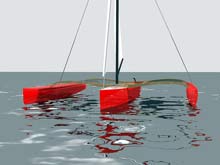
|
Adding to my desire for a truly capable boat, Gary Dierking
released plans for his Wa’apa in his book. Additionally,
he designed and built a new three board canoe called Easy Rider
in some 60 hours. He is coming out with a plan set soon for
this canoe as well, and it is to feature full decking and self
bailing footwells. These two items are especially appealing
to me since my Ulua’s 11’ open cockpit is a bit
concerning on rough water days and the impetus for the conversion
back to the traditional outrigger. Even swamped it would stay
afloat, but self rescue would be challenging. I think the end
result, while still up in the air between the Cardiff 21 and
Gary’s Easy Rider, will end up siding with Gary’s
Easy Rider in the short term especially since I need only to
construct the main hull. In addition, I could use the Easy Rider
hull as a catamaran hull, something I wanted to do since my
first foray into canoe building.
See "Boats
Can Be Crazy Things"
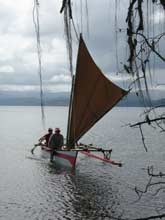 |
Here’s a shot of
Gary and his wife paddling back to shore in Easy Rider.
Note the freeboard |
| This photo is of Gary’s sectional Wa’apa
at 24’ |
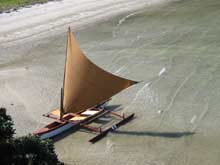
|
Gary has also designed an Easy rider for me that uses a fully
decked canoe hull with self bailing cockpits. This would address
the problems I’ve had with the Ulua and give me an opportunity
to build a second canoe which fulfills my original design idea.
The sketch below is what I will also be giving serious thought
to doing.
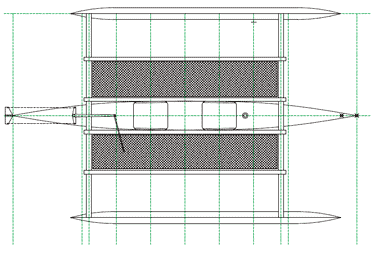
Easy Rider - click to enlarge
After rereading the first article,
I realized that the concept of a versatile boat that can be
used sans rig as a paddling craft, a sailing outrigger canoe,
a trimaran, and a catamaran is not all that farfetched after
all. I definitely strayed from the original path that Gary designed
for the Ulua, but after rereading his
book, the ability to mix and match components goes
way back. The Ho’omo idea is still a possibility for costal
cruising and the quick construction makes for a boat house full
of outriggers! This winter will likely see Gary’s Easy
rider under construction in my shop and possibly some new
amas as well. The idea of some costal camping with my growing
family also gets my wheels turning and makes me think of the
Ho’omo made from three board canoes!
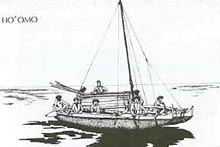 |
Traditional double canoes
were lashed together and often had platforms for a deck. |
Dan St. Gean
*****
More articles by Dan St. Gean:

